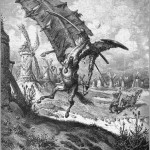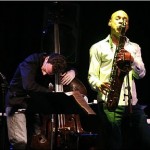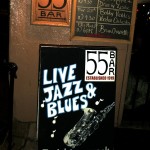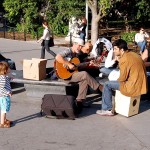A Partial Chronology of Butchered, Bruised, Worn, Defective, and/or Repurposed Recordings I Have Known
Analog, sigh. It was a time of cobbling, of gaps and seams, of defects as a matter of course. A combination of economy—blank cassettes cost an order of magnitude more than blank discs—and technology—the culture of obsolescence that arose around the inability to manipulate damaged discs. Now, discs have given way to a shadow-world of music without material form, without fingerprints.
It’s true that a recording is always to some degree a ghost. But as the technology has changed, and with it the recording artifact, so our relationship to music has changed as well. It’s less intimate, I think, than it used to be. Less personal. The once-obvious seams and crooked hems, the weird silences and truncated ends, the nicks and quirks and tics and scratches and skips: there were just so many spaces we could fit ourselves into. So many things could go wrong without scuttling everything, and there was so much room for us to screw up. And then we had to learn to live with it, like we had to learn to live with the imperfections of our friends and siblings, our parents, our lovers, ourselves. Accident or defect (occasionally a happy one) or a history of wear marked recordings as ours, and marked us in turn. It didn’t make them obsolete; in fact, sometimes it made them that much more valuable, that much more endearing. An old scar, a maimed rescue. A paperback held together by rubber bands. Jeans you couldn’t wear out of the apartment—we used to be able to wear our music that way.
This is not intended as an exercise in nostalgia, personal or historical, though nostalgia does have its place here, of a weirdly masochistic sort: for the sometimes maddening way our music misbehaved, and that we misbehaved with it, wrestling with the plastic-yet-resilient media in which it was embodied, and which we quite consciously took for it. Our suffering and our struggle created a relationship, a bond. A mutual devotion.
Without further ado, then, a very partial chronology of my three-legged dogs.
*
1981. When David Z. got Moving Pictures and Dirty Deeds for his thirteenth birthday, we played “Tom Sawyer” over and over until the kid who lived on the other side of David’s semi-detached house, who was a year or two older than us and wore a gold chain, told us to stop. That day left a groove in my ear. Or maybe a skip. Before I ever got a chance to tape Moving Pictures, this same neighbor got hold of it, and—so his story went—his little sister whacked the needle while the record was playing, right at the beginning of “Tom Sawyer.” How convenient, having a younger sibling, particularly a younger sister, for a patsy. Maybe it was his way of getting revenge on us, for killing that song before it even had a chance to be born. Maybe he was calling attention to the fact that we were acting like a scratched record, picking up the needle and carrying it back to the beginning of “Tom Sawyer.” Anyway, when I put David’s record on to tape it, the opening synth swoosh had been chopped in half; the record jumped right to a heavily-truncated first verse: “A modern day war—” and then into the main chord progression. That was the Moving Pictures I taped. I listened to it relentlessly. It was the only version of “Tom Sawyer” I knew, unless I happened to catch the song on the radio, or hear it at another friend’s house, until I bought Moving Pictures on cassette a year or two later.
1982. My store-bought cassette of 2112 was defective. In the last section of the side-long title track, Alex Lifeson is supposed to intone “We have assumed control” three times, and then whammy-bar the low E until the feedback rings out the song. But on my tape he said it only once, and then the music, the climactic, cataclysmic roar of “VI. Grand Finale,” abruptly stopped, followed by the tape itself, Click—this being a time when the technology of recording was not so far removed from that of mousetraps. On side 2, “A Passage to Bangkok” picked up with the last two notes of the “oriental riff,” and Geddy Lee started right in with “Our first stop is in Bo-gota,” etc. The opening unaccompanied guitar riff was entirely missing—which makes sense, as it was the other side of the same chunk of tape that should have contained the end of “2112.” I always figured that tape was fucked up, but never had the gall to return it. I mean, what if the much older, much cooler record store clerk looked me in the eye and said, “Retard, it’s supposed to end that way?” Could I really risk being that much of a loser? About my favorite band? And so I didn’t hear how “2112” really ended until I bought the live album All the World’s a Stage the following year. But that is an abridged live version, so how could I really say they hadn’t changed the ending for the concert? Here’s the real kicker: When I finally bought 2112 on record and heard the “real” end of “2112,” I was disappointed. In terms of endings, it’s by far the weakest of the three side-long suites the band produced, utterly deus ex machina, as abrupt and contrived in its way as my defective tape. At least the cut-off ending had a certain daring, an admission of failure, like one of those “O! Something!” Melville endings. Suffice to say it’s become quite precious to me now, all that missing music. Or at least “2112” has. “Bangkok” really suffered. The problem is I couldn’t put one back without the other.
1983. I’m still tight with Billy Joel’s Glass Houses, but there was period when I believed I should disparage it, a rite of passage, you might say, and what better way to do so than to record Iron Maiden’s The Number of the Beast right over top of it? I mean, steamroller that Billy Joel shit into oblivion. I remember the thrill of learning you could actually do this by stuffing wads of toilet paper into the square notches (a.k.a. love handles) in the corners of a cassette. Blank tapes had little tabs over these notches; after you made a recording, you were supposed to break them—the ends of scissors worked well for this—to safeguard the product. But it turned out that even if you broke the tabs, you could reverse the process with wadded toilet paper. And so you could repurpose any store-bought tape. In fact, you could record over anybody’s shit, if you had that sort of a mean streak in you. Man, I loved popping Billy Joel into the cassette player and having Maiden come out the speakers. Instead of “You May Be Right,” “In-VA-ders.” Maiden, my mighty Norsemen, severing the limbs and burning the corpse of that wretched Saxon Joel.
1983. I copied my friend’s Screaming for Vengeance record over one of my dad’s classical piano tapes. I’m sure I had his permission. (I’m not being ironic.) When I put the tape on, there was this lovely little piano lick—seven or eight climbing notes, lasting maybe a second and a half—and then, Bwaaaang!, “The Hellion,” SFV’s instrumental prelude, landed on it like an atom bomb. Here’s my best guess how this happened: Cassettes have about five seconds of lead before the magnetic tape begins. When you taped a record, you had to make sure to start recording after the lead; otherwise, the music would start before the magnetic tape did, and you’d miss the beginning. (In fact, since the piano lick starts in the middle of a phrase, this is likely what happened to my father—which was maybe why he gave me the tape to use.) The easiest way to skip the lead was to turn the wheels of the cassette manually, with a pen or your fingernail, until the black magnetic tape appeared, then insert it in the recorder, set PAUSE and RECORD, drop the needle, and un-PAUSE. But if you forwarded past the lead, and there was something already recorded on the tape … well, there it stayed. I still can’t listen to “The Hellion” without hearing that scant piano lick—it adds so much to the song it’s a shame the Priest didn’t think of it themselves. It probably helps that, in all these years, I’ve never been able to figure out what the piece is.
1985. I spent a lot of time this year copying classical records from my parents’ collection, including one of Beethoven’s Ninth Symphony with Wilhelm Furtwängler conducting the Bayreuth Festival Orchestra. The ppppp introduction of the “Freude” theme is, as you may recall, bowed on the basses; and the dynamics of the symphony are such that, unless you’re blasting the whole thing—which I wholly endorse—you can’t even hear this introduction without turning the stereo way way way up. And even then you’ve got to crouch beside the speakers and hold your breath, feeling about as deaf as Beethoven. On that old record—or rather, the tape I made from it—the imperfections in the vinyl are louder than the basses; the theme is almost lost in the hiss; the music seems so insubstantial that the medium is straining to capture it, like neutrino tracks caught in miles of lead. There is something about being on the cusp of not hearing the beginning of that theme, those yearning basses so deeply buried in the hiss and crackle, rising as the theme develops and is distributed throughout the orchestra, that (for me) cannot be disassociated from the symphony itself. As though the limits of the medium reflected the the very distance from which the theme had to travel to reach us, and the impossibility of our yearning as we try to reach through the material that stands between ourselves and the music, an otherworldly visitor. Such hamstrung listening was also about creating the figure of Beethoven for this impressionable and romantic teenager.
1986. When Judas Priest sold out with Turbo, I threw the jilted fan’s tantrum and recorded over all my Priest.* Or almost all. A lot of it, anyway. I kept two ninety-minute cassettes’ worth—I wasn’t quite so betrayed, I guess, that I couldn’t carefully preserve my favorite material: Unleashed in the East in its entirety, and select songs from the rest of their catalog—like an enraged divorcee stumbling out of the house with her favorite lamp tucked under one arm. The challenge was to keep certain songs on albums without using more tapes (one doesn’t squander precious resources on the Judas, the scab, the snitch). So I had to find equivalent-length songs to squeeze into the gaps created by the songs I was deleting. Of course, though I tried every possible mathematical combination, there were no exact matches, and three sides of those tapes (that is, the sides without the untouchable Unleashed in the East) are marked by unnaturally long gaps where I had to let silence fill the space until the next previously-recorded track. There is also at least one glaring error (“The Last Rose of Summer,” I think, partially retained). (N.B.: I had taped my Priest off a friend with whom I no longer spent time; he had taped my Maiden; this was typical of the symbiotic relationship that defined music trading in those days, i.e., pooled money, shared resources.)
1987. My record of Permanent Waves had a skip right where “Natural Science” moves into part 2, “Hyperspace,” so Geddy Lee would sing “Our causes can’t see their e-ffects,” followed by a short tom roll, and then the song would go on: “e-ffects” (buddulup-bup-bup) “e-ffects” (buddulup-bup-bup) “e-ffects,” etc. And not even on beat: the tom roll ended a little early, not quite a full measure, which in itself was tricky and sort of cool, at least the first few times, and, in hindsight, points the way toward a detour to some other relationship to my music, a perilous road not taken, at least until some years later.** Whenever I listened to that record, I had to remember to walk over to the turntable and knock the needle gently out of its groove so I could hear the rest of the song, and save myself and my band from the limbo of e-ffects (buddulup-bup-bup). Since I no longer had my store-bought cassette handy, just as happened with “Tom Sawyer,” I got used to hearing “Natural Science” this way until 2009 or so, when I found another copy in a crate of records someone was getting rid of in the basement of my Harlem co-op. The super had already taken his pick.
1991. The year of the Police Squad! mix (in color!), among the finest mixed tapes ever made. I hope its recipient, Patrick U., has kept it, with the intention of eventually bequeathing it to a museum. It paired choice late ‘80s/early ‘90s rock with snippets from the TV show Police Squad! (e.g.: “Who are you, and how did you get in here?” Leslie Nielson: “I’m a locksmith, and … I’m a locksmith.”) But as with so much of this time, it is also a recording of a process: walking down the stairs to where the TV/VCR was; setting the tape up in the little portable tape deck (the sort with the retractable handle in front of the deck and the single speaker behind it, the generation before the boombox); getting the VCR ready; waiting for the house to be quiet; recording open-air. Then trudging back upstairs to the living room, where the stereo with the CD and turntable was, to record a couple more songs; then back downstairs, etc. Of course it sounded good, the way the berries you pick taste better.
1993. At the end of my first year of grad school, I got a tape of An Anthology of Tom Waits from a friend; it was taped over a Vanilla Ice cassette that her Japanese students had given her as a gift. She had turned the label inside out, matching her purple cursive against their green print. I value the names of Vanilla Ice songs written in the hand of Japanese students I will never meet almost as much as my friend’s cursive … though neither as much, it must be admitted, as hearing “Ol’ 55” or “Diamonds on my Windshield” or “The Piano Has Been Drinking” or “Burma Shave” for the first time.
1998-9; 2002-3. An ambitious project of making salsa mixes from Latin music shows on Columbia’s WKCR 89.9—initially “Caribe Latino,” which used to air on Monday nights from 10-12, and then Friday Night’s “Mambo Machine,” as well as occasionally the cumbia show on Wednesday eves, and the Sunday-afternoon Latin shows on WBAI, although their yield was considerably lower. I wouldn’t hear the tapes until the next day or weekend, like they were traps set for crabs. (When the show was on I was usually grading papers with the volume all the way down, or out somewhere.) Had I (or my partner) flipped the tape without missing too much between sides? Had I gotten so lucky as to record the part of the show where the DJ rattled off names and artists? It was, to say the least, an imperfect process. There are tracks that cut off in the middle, and tracks that start in the middle, and tracks with gaps in their middles where the tape had to be flipped, though the bits I got, whether beginning or end or beginning and end, were too good to throw back into the sea. There were tapes that caught the first half-hour of the graveyard experimental/ambience program “Transfigured Night,” which was the first way I ever heard Runes, for example, and speaks to the happy accidents and contingencies that come of casting the net widely—you’d be surprised at the sort of things that lurk in the abyssal deeps of radio. And then there is one whole side of a 90-minute tape (I think it’s volume 7 of the 22 I managed to finish) where the radio signal was coming in … poorly. It was the Machito festival—KCR specializes in marathon broadcasts to celebrate artists’ birthdays and passings—and they were playing all this son stuff from the thirties, and where the fuck was I going to find that again, back in 1999? There are places where the static is so bad you can’t even hear the music. Maybe I was a fool to keep it. But there it is, Machito, fading in and out, and me like a ham radio operator, catching the electromagnetic waves from some Siberia of time, an echo-wave reaching me from deep in the past.
*
Enough. But I’ve barely scratched the surface. All those tapes glitched by the faulty connection in the white jack in the back of the receiver, so that the lefthand speaker crackled and made bands stutter (e.g., Maiden, “Die With Your Boots On”: “No point a-a-asking who’s to blame.”). The Forbidden Evil tape that would garble and unspool, a loop like a hernia, that my friend Pat F., who worked in the local video store, helped me to cut and splice, so that it worked again, but a couple of seconds of “Through Eyes of Glass” were lost, right as the song is leading into the second verse, “My mind is one, now has the crystal power,” etc. An entire post could be written about mixed tapes, audio letters and sentimental objects par excellence.
But to return to the issue of materiality. It might be argued that music exists somewhere beyond the medium of the recording, in some essence apart from it, and to seek perfection in technologies of reproduction is to allow us to better approach and perhaps capture its spirit. My Beethoven example above seems to suggest this, although it is encased in metaphor.
Yet, I would tend to the opposite: the recording is the music, or all we can have of it. Or, perhaps better put, the recording as a physical object exposes the essentially and inescapably material nature of music. And never moreso than when a recording is mangled or otherwise faulty. A music-phobic way to listen to music, then, to try to purify it of the very stuff from which it is made. To imagine bathwater and baby so essentially different. I think that we have lost a certain solidarity with the material world; and, lacking it, we have come to lack something in our relationship to art, which is, first and foremost, material.
And so, when I hear people talking about their high-fidelity systems, their 180-gram mint-condition vinyl, their thousand-dollar needles, their surround-sound speaker set-ups, their subwoofers that make the glass of water set upon their marble countertops shudder as if Jurassic Park’s T. Rex were walking by … how can I help but sigh? Give me ink smeared thick as frosting across a smooth white page. Give me a typewriter with a broken TAB key and a ribbon you have to rewind by hand, like the magnetic tape of a cassette. I want to be able to feel the way the nibs of different pens slide across surfaces of different kinds of paper, feel the ridge of the slight dent made by the typewriter keys, as though it were braille, hear the din of language being made in the smoking factory of thought. Give me a music, as much as a language, that I can touch. Speakers bowing under the weight of sound, smouldering oil lamps, sawdust and stale beer, the creak of old pews, or of an old guitar when a string is torqued one step higher.
Spirit, spirit, spirit. Haven’t we had enough of that? If I can’t touch it, can’t smell it, does it deserve to be called music?
* I have heard this sort of thing was widespread in 1991, when Metallica released the “black” album, and betrayed fans everywhere responded by etching out the Metallica from their collections. Two points follow. One, betrayal is, of course, a powerful way to create cohesion, and it might be said that Metallica’s apostasy produced the genre of thrash metal as a discrete historical object—that it couldn’t have become so without that boundary-forming betrayal (as, earlier, thrash bolstered its identity by defining itself against the apostasy of hair metal). Second, consider that Metallica’s apostasy is perched on the cusp of metal’s splintering into a number of subgenres. I have compared the circa-2005 thrash revival to the Second Great Awakening (“Burned-over,” 8.3.11), and now I wonder if a similarly fruitful comparison couldn’t be made to 1991: the mainstream deemed to have fallen away from the true faith, and the subsequent (or concomitant?) splintering of the genre into sects.
** Not to suggest that my relationship to music was entirely devoid of irony or humor. One of my first great mixing projects (with a friend) was to create a song composed of lines from Rush songs in combinations that made them ridiculous, like an audio version of those channel-changing cartoons in Mad magazine (e.g.: “We will call you Cygnus, god of/ [click] The hypocrites.”). And talk about seams: this mix was so primitive that it was pretty much nothing but seams. That said, there’s no question that we often need to be pushed out of our listening grooves, and, as at least two of the entries above suggest, such defects can open up new ways of listening. Not to add to hip hop apocrypha, but it’s not difficult to imagine that damaged vinyl played a role in the origins of sampling, just as scratching re-purposes the recording artifact for ulterior musical ends. (… But then where to put Steve Reich?)
Addendum, 5.25.16. On reflection, I think there is another reason why I tend to privilege recorded artifacts over streaming music from the web. It goes back to a comment sociologist Keith Kahn-Harris made about listening in the internet age, which I discussed in “T-shirts and Wittgenstein” (5.24.13): that the instant availability of music creates a “crisis of abundance,” leaving the listener without the time necessary to process, or engage deeply with, or fully reflect upon, what he or she hears. Recursivity and focus is replaced by breadth, and—this more an echo of the recent stream of publications about cognition and the net—the listening mind comes to mimic the web. In this regard, the artifact serves as a kind of stopper, the proverbial finger in the dike holding back the sea of music raging behind it; a means to manage the rate of access to new music that would otherwise deluge us. We might say this is a subsidiary role of all media: not just to provide access, but to limit, to act as a screen. To some, such a choice of listening habits may sound parsimonious, even Puritanical. I would prefer to think of it as Hellenic: the ideal of moderation, a means of maintaining or restoring some measure of (in this case) aesthetic health in an age of decline.











